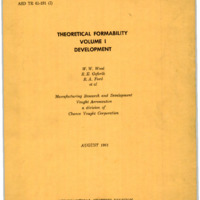-
Title
-
Theoretical Formability. Volume I. Development
-
Description
-
The "cut-and-try" method of determining sheet metal formability has long been the standard practice in the aircraft industry. This two-volume report presents methods of determining formability analytically for the twelve most common processes of forming sheet metal. This method is based on utilization of a material's mechanical properties to predict formability.
The first volume on development gives the procedure used to arrive at the objective of predicting formability. First, basic limit equations are developed relating geometry of the parts to the material properties. These equations are used to determine the shape of the limit graphs and to give indices relating formability to the material. Then, experimental parts are formed to position the theoretically shaped curves with the aid of the formability indices.
The second volume on application is presented in handbook form giving design and manufacturing information for nineteen materials in the program. These materials covered some of the most currently used alloys: (1) magnesium, (2) aluminum, (3) titanium, (4) stainless steel, (5) tool steel, (6) nickel and cobalt base and (7) refractory metals. Graphs, equations, and design tables are presented for each process, statistically proven with experimental work comprising a total of approximately twenty-one-thousand formed parts.
-
Date
-
1961
-
Index Abstract
-
Contrails and DTIC
-
Photo Quality
-
Incomplete
-
Report Number
-
ASD TR 61-191 (I)
-
Creator
-
Wood, W. W.
-
Goforth, R. E.
-
Ford, R. A.
-
Corporate Author
-
Vought Aeronautics
-
Laboratory
-
Directorate of Materials and Processes
-
Extent
-
381
-
Identifier
-
ADA286700
-
Access Rights
-
OTS
-
Distribution Classification
-
1
-
DTIC Record Exists
-
Yes
-
Distribution Change Authority Correspondence
-
None
-
Abstract
-
The "cut-and-try" method of determining sheet metal formability has long been the standard practice in the aircraft industry. This two-volume report presents methods of determining formability analytically for the twelve most common processes of forming sheet metal. This method is based on utilization of a material's mechanical properties to predict formability.
The first volume on development gives the procedure used to arrive at the objective of predicting formability. First, basic limit equations are developed relating geometry of the parts to the material properties. These equations are used to determine the shape of the limit graphs and to give indices relating formability to the material. Then, experimental parts are formed to position the theoretically shaped curves with the aid of the formability indices.
The second volume on application is presented in handbook form giving design and manufacturing information for nineteen materials in the program. These materials covered some of the most currently used alloys: (1) magnesium, (2) aluminum, (3) titanium, (4) stainless steel, (5) tool steel, (6) nickel and cobalt base and (7) refractory metals. Graphs, equations, and design tables are presented for each process, statistically proven with experimental work comprising a total of approximately twenty-one-thousand formed parts.
-
Report Availability
-
Full text available
-
Contract
-
AF 33(616)-6951
-
DoD Project
-
7381
-
Distribution Conflict
-
No
-
Date Issued
-
1961-08
-
Provenance
-
IIT
-
Type
-
report
-
Subject
-
Sheet Metal
-
Material Forming
-
Mechanical Properties
-
Aircraft Industry
-
Graphs
-
Shape
-
Spinning (Industrial Processes)
-
Stretch Forming
-
Calendering (Sheet Forming)
-
Metal Forming Brakes
-
Production Control
-
Standards
-
Geometry
-
Utilization
-
Rolling (Metallurgy)
-
Drawing (Forming)
-
Publisher
-
Wright-Patterson Air Force Base, OH : Aeronautical Systems Division, Air Force Systems Command, United States Air Force
-
Format
-
1 online resource
-
Date Modified
-
Scanned by request 2023-12-07 submitted by University of Wichita (University - Domestic)
 ASD TR 61-191 (I)
ASD TR 61-191 (I)